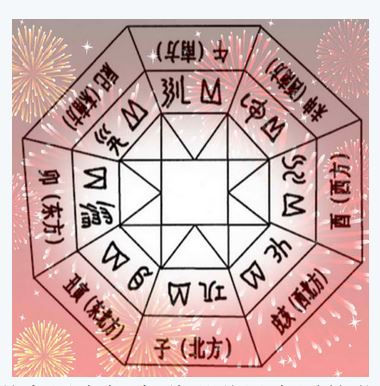Most of the ethnic groups in southwest China believe that we humans are an integral part of the cosmos, a view of the universe that can be traced back to the ancient Chinese civilization thousands years ago. They believe in the existence of divinities and express their faith through wearing their traditional garments in the modern society. The Yi ethnic groups embroidered on their clothes the original patterns of the mystical he-tu and luo-shu diagrams, holograms of the structure of the universe which are believed to be bestowed by God and handed down from before this civilization around 5500 years ago. The Miao ethnic groups dressed up in clothes embroidered with deities and divinities when they were in ceremonies worshiping the heavens and the gods, maintaining harmony between Man and Nature.
Most of the ethnic groups in southwest China believe that we humans are an integral part of the cosmos, a view of the universe that can be traced back to the ancient Chinese civilization thousands years ago. They believe in the existence of divinities and express their faith through wearing their traditional garments in the modern society. The Yi ethnic groups embroidered on their clothes the original patterns of the mystical he-tu and luo-shu diagrams, holograms of the structure of the universe which are believed to be bestowed by God and handed down from before this civilization around 5500 years ago. The Miao ethnic groups dressed up in clothes embroidered with deities and divinities when they were in ceremonies worshiping the heavens and the gods, maintaining harmony between Man and Nature.
薩 滿 之 路
「薩滿」saman來自滿語及其他通古斯語族語言。在通古斯語中是「智者」、「曉徹」的意思,且意指有能力進入入神狀態,並能與神溝通之人。
薩滿信仰中的薩滿被認為是掌握神秘知識,有能力進入「人神」狀態的人,有著預言、治療,與屬靈世界溝通,以及旅行到屬靈世界的能力。薩滿會作為一個巫醫、術士、驅魔師、占卜師、亡靈巫師或靈魂行者。在中國西南地區,各個民族都有不同的薩滿,他們是神靈世界的守護著,也是現實世界中最後的通靈人。
復活的史前文明
復活的史前文明
Most of the ethnic groups in southwest China believe that we humans are an integral part of the cosmos, a view of the universe that can be traced back to the ancient Chinese civilization thousands years ago. They believe in the existence of divinities and express their faith through wearing their traditional garments in the modern society. The Yi ethnic groups embroidered on their clothes the original patterns of the mystical he-tu and luo-shu diagrams, holograms of the structure of the universe which are believed to be bestowed by God and handed down from before this civilization around 5500 years ago. The Miao ethnic groups dressed up in clothes embroidered with deities and divinities when they were in ceremonies worshiping the heavens and the gods, maintaining harmony between Man and Nature.
Spiral pattern
From the Milky Way Galaxy to our fingerprints, the spiral pattern is one of the most widely spread and recognized symbols which are found among most of the prehistoric relics in the world.This spiral pattern, meaning “to return,” is one of the Chinese oracle-bone script, an early form of the Chinese written language used in the Chinese Bronze Age originating about 3,600 years ago.The Milky Way Galaxy is not our real home. It is the way to return home. Are we human beings on the way home? The answer is in our own hands, relies on our own behavior.The ethnic groups in southwest China had embroidered “the way home” on their clothes. They believed that the place where their original true self was created was among the stars in the sky. It was their real homeland. They wear the symbols to remind themselves the way home.









Before the Nazis hijacked the symbol (Swastika in English), “卍” had a long history throughout the world. Archaeologists have found evidence of the symbol’s use everywhere from Europe to Africa to Asia, going back thousands and thousands of years to the Iron and Bronze Ages. The first known archeological srivatsa, the earliest srivatsa ever found was uncovered in Mezine Ukraine, carved on an ivory figurine estimated 10-12000 years old.“卍” is a Buddha School symbol of srivatsa, interpreted as “mighty virtue” by the famous Chinese Buddhist monk, Xuanzang in the seventh century. In Sanskrit, srivatsa means “the gathering of all good fortune” (refer to the Ci Hai dictionary). Each of the four arms of “卍” extends outwards and can be evolved into various brocade patterns used to symbolize the long-lasting fortune and life.













This symbol represents the traditional Chinese philosophy: Destructive and productive relationships between two things. Lao Tzu, a 6th century Chinese philosopher wrote in his book Tao Te Ching: " Tao produces one (universe), One produced two (of YIN and YANG), Two produced three (of Heaven, Earth and Man), Then varied and are borne the universe of all things. All things turn their back towards YIN, Facing the Sun to hug for YANG, where vigorous energy stirs in harmony with each other."The Huainanzi- Patterns of Heaven, an ancient Chinese essay collection before 139 BC., talks about the origin and evolution of the heavens and the earth. It is believed that after the division of the chaos, the heavens and the earth are divided, when the lighter rises as the sky, the heavy turbidity condenses as the ground; the heavens are YANG, the earth is YIN. These two interact and produce everything.“The Tao is the way according to which YIN and YANG change.” That is, the Tao is the Law of the Movements of the Universe and the Changes of Nature, also known as “the Way of Heaven”. We human beings need to follow the way of heaven and it leads to prosperous results, otherwise would die out eventually.























